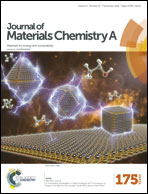Self-assembling solid-state hydrogen source for drylands photocatalytic hydrogen production†
Abstract
Water finding, collection and retention are important issues in drylands because of the rareness and high evaporation of water. Efficiently and fully utilizing water for photocatalytic hydrogen production is thus a challenge in desert areas. Inspired by the decent water absorption and retention properties of super absorbent polymers (SAPs), it is a bracing idea to use SAPs for water storage and hydrogen production reactors to enable full use of precious water for light-driven water splitting. Herein, for the first time, we have prepared a self-assembling solid-state hydrogen source (SHS) for photocatalytic hydrogen evolution. In the SHS, Pt/TiO2 and NiB/CdS nanocomposites were used as solar-driven and visible-light driven hydrogen production model catalysts, respectively, integrated with commercial agricultural acrylamide-acrylate copolymerized crosslinked SAP (AAC). It exhibits hydrogen production comparable to that of a typical suspension system, is reusable, and can be more readily recycled than conventional powdery catalysts, because of its monolithic structure. All water molecules in the SHS can be used to produce hydrogen. Accordingly, the SHS developed in this work offers a strategy for integrating SAPs with catalysts that would be practical in water-efficient photocatalytic hydrogen evolution in drought regions.


 Please wait while we load your content...
Please wait while we load your content...